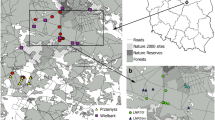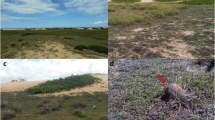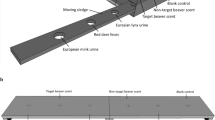Abstract
We tested the hypothesis that a main function of territory marking in Eurasian beaver (Castor fiber) is defense of the territory. The results showed that: (1) beaver colonies with close neighbors scent-mark more often than isolated ones; (2) the number of scent markings increased significantly with the number of neighboring territories and individuals, the mean distance to all other territories, duration of territory occupancy and length of wooded banks within the territory; (3) the number of scent markings by a colony was not related to the number of animals in the colony, the distance to nearest neighbors' main resting-site, or age of beaver; (4) the number of scent mounds or scent markings in territories with breeding and nonbreeding beaver did not differ; (5) there was no significant difference in the number of scent markings during the season (16 April–31 August); and (6) some of the scent mounds were concentrated at feeding sites, resting sites, and near trails, but most had no apparent relationship to any of these sites. Therefore we concluded that scent marking apparently plays an important role in territory defense of the Eurasian beaver.
Similar content being viewed by others
REFERENCES
ALEKSIUK, M. 1968. Scent-mound communication, territoriality, and population regulation in beaver (C. canadensis Kuhl). J. Mammal. 49:759–762.
ANDERSSON, A., and WESTERLING, P. 1984. Doftmarkering hos europeisk bäver. Viltnytt 19:2–12.
BEER, J. R. 1955. Movements of tagged beaver. J. Wildl. Manage. 19:492–493.
BERGERUD, A. T., and MILLER, D. R. 1977. Population dynamics of Newfoundland beaver. Can. J. Zool. 55:1480–1492.
BOLLINGER, K. S. 1980. Scent marking behavior of beaver (Castor canadensis). MS thesis. University of Massachusetts, Amherst, 186 pp.
BUECH, R. R. 1995. Sex differences in behavior of beavers living in near-boreal lake habitat. Can. J. Zool. 73:2133–2143.
BUTLER, R. G., and BUTLER, L. A. 1979. Towards a functional interpretation of scent marking in the beaver (Castor canadensis). Behav. Neural Biol. 26:442–454.
FABEL, J. W. 1977. Scent-mounding in a population of beaver (Castor canadensis) in southwest Ohio. MS thesis. Ohio University, Athens, 18 pp.
GEIST, V. 1964. On the rutting behavior of the mountain goat. J. Mammal. 45:551–568.
GORMAN, M. L. 1990. Scent marking strategies in mammals. Rev. Suisse Zool. 97:3–29.
GOSLING, L. M. 1982. A reassessment of the function of scent marking in territories. Z. Tierpsychol. 60:89–118.
GOSLING, L. M. 1990. Scent marking by resource holders. Alternative mechanisms for advertising the costs of competition, pp. 315–328, in D. W. Macdonald, D. Müller-Schwarze, and S. E. Natynczuk (eds.). Chemical Signals in Vertebrates. Oxford University Press, Oxford.
HARTMAN, G. 1994. Ecological studies of a reintroduced beaver (Castor fiber) population. PhD dissertation. The Swedish University of Agricultural Sciences, Uppsala.
HAY, K. G. 1958. Beaver census methods in the Rocky Mountain region. J. Wildl. Manage. 22:395–402.
HEDIGER, H. 1949. Säugetier-Territorien und ihre Markierung. Bijdr. Dierkd. 28:172–184.
HEIDECKE, D. 1991. Zum Status des Elbebibers sowie etho-ökologische Aspekte. Seevögel 12:33–38.
HODGDON, H. E. 1978. Social dynamics and behavior within an unexploited beaver (Castor canadensis) population. PhD dissertation. University of Massachusetts, Amherst, 292 pp.
HOULIHAN, P. M. 1989. Scent mounding by beaver (Castor canadensis): Functional and semiochemical aspects. MS thesis. State University of New York, College of Environmental Science and Forestry, Syracuse, 184 pp.
KLENNER-FRINGES, B. 1992. Revitalization of river banks by the beaver (Castor fiber albicus Matschie, 1907)—a research project, pp. 141–153, in R. Schröpfer, M. Stubbe and D. Heidecke (eds.). Semiaquatische Säugetiere. Wissenschaftliche Beiträge/Martin-Luther-Universität, Halle-Wittenberg.
MAYNARD SMITH, J. 1976. Evolution and the theory of games. Am. Sci. 64:41–45.
MAYNARD SMITH, J., and PARKER, G. A. 1976. The logic of asymmetric contest. Anim. Behav. 24:159–175.
MOLINI, J. J., LANCIA, R. A., BISHIR, J., and HODGDON, H. E. 1980. A stochastic model of beaver population growth, pp. 1215–1245, in J. A. Chapman and D. Pursey (eds.). Proceedings, Worldwide Furbearer Conference, Frostburg, Maryland.
MÜLLER-SCHWARZE, D., and HECKMAN, S. 1980. The social role of scent marking in beaver (Castor canadensis). J. Chem. Ecol. 6:81–95.
MÜLLER-SCHWARZE, D., and HOULIHAN, P. W. 1991. Pheromonal activity of single castoreum constituents in beaver, Castor canadensis. J. Chem. Ecol. 17:715–734.
MYKYTOWYCZ, R. 1965. Further observations on the territorial function and histology of the submandibular cutaneous (chin) glands in the rabbit, Oryctolagus cuniculus (L.). Anim. Behav. 13:400–412.
NITSCHE, K. A. 1985. Reviermarkierung beim Elbebiber (Castor fiber albicus). Mitt. Zool. Ges. Braunau. 4:259–273.
NOLET, B. A. 1995. Distribution and number of beaver Castor fiber in the Netherlands in the period 1988–1994. Lutra 38:30–40.
NOLET, B. A., and ROSELL, F. 1994. Territoriality and time budgets in beavers during sequential settlement. Can. J. Zool. 72:1227–1237.
NOLET, B. A., VAN DER VEER, P. J., EVERS, E. G. J., OTTENHEIM, M. M. 1995. A linear programming model of diet choice of free-living beavers. Neth. J. Zool. 45:315–337.
NORUSIS, M. J. 1990. SPSS Base System User's Guide. SPSS, Inc., Chicago.
PIECHOCKI, R. 1977. Ökologische Todesursachenforschung am Elbebiber (Castor fiber albicus). Beitr. Jagd. Wildforsch. 10:332–341.
RICHARDSON, P. R. K. 1991. Territorial significance of scent marking during the non-mating season in the aardwolf Proteles cristatus (Carnivora: Protelidae). Ethology 87:9–27.
SCHULTE, B. A. 1993. Chemical communication and ecology of the North American beaver (Castor canadensis). PhD dissertation. State University New York, Syracuse, 194 pp.
SCHULTE, B. A., MULLER-SCHWARZE, D., TANG, R., and WEBSTER, F. X. 1994. Beaver (Castor canadensis) responses to major phenolic and neutral compounds in castoreum. J. Chem. Ecol. 20:3063–3081.
SIEGEL, S., and CASTELLAN, N. J. 1988. Nonparametric Statistics for the Behavioral Sciences. McGraw-Hill, New York.
SVENDSEN, G. E. 1980a. Patterns of scent-mounding in a population of beaver (Castor canadensis). J. Chem. Ecol. 6:133–148.
SVENDSEN, G. E. 1980b. Population parameters and colony composition of beaver (Castor canadensis) in southeast Ohio. Am. Midl. Nat. 104:47–56.
TANG, R., WEBSTER, F. X., and MÜLLER-SCHWARZE, D. 1993. Phenolic compounds from male castoreum of North American beaver, Castor canadensis. J. Chem. Ecol. 19:1491–1500.
TOWNSEND, J. E. 1953. Beaver ecology in western Montana with special reference to movements. J. Mammal. 34:459–479.
WALRO, J. M. 1980. Castor and anal glands of North American beaver (Castor canadensis): Histology and communicatory functions of secretions. PhD dissertation. Ohio University, Athens, 98 pp.
WELSH, R. G., and MÜLLER-SCHWARZE, D. 1989. Experimental habitat scenting inhibits colonization by beaver, Castor canadensis. J. Chem. Ecol. 15:887–893.
WILSSON, L. 1971. Observations and experiments on the ethology of the European beaver (Castor fiber L.) Viltrevy 8:115–266.
Rights and permissions
About this article
Cite this article
Rosell, F., Nolet, B.A. Factors Affecting Scent-Marking Behavior in Eurasian Beaver (Castor fiber). J Chem Ecol 23, 673–689 (1997). https://doi.org/10.1023/B:JOEC.0000006403.74674.8a
Issue Date:
DOI: https://doi.org/10.1023/B:JOEC.0000006403.74674.8a




